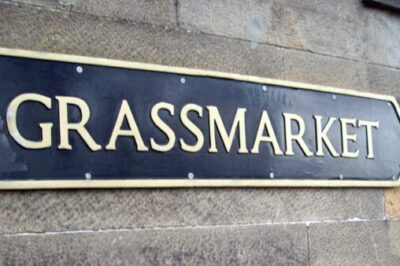
Grassmarket and other Old Town streets
The Edinburgh Old Town streets of Grassmarket, Cowgate, Victoria Street and West Bow lie close to the Royal Mile which stretches from the imposing bulk of Edinburgh Castle to the more genteel surroundings of the Palace of Holyroodhouse.
For centuries, these streets have been home to many of the most important institutions in the city.
Among them, were Scotland’s parliament (until 1707), where that Scottish Patriot Andrew Fletcher fought hard against the Union and St Giles’ Cathedral, the High Kirk of Scotland, where John Knox’s thunderous call to the Protestant faithful was often heard.
Important too was the Mercat Cross, where royal proclamations and other important announcements were issued to an expectant crowd.
Grassmarket Edinburgh
However, for those visitors to Edinburgh, content to explore only its most obvious historical and cultural treasures is to overlook many of the city’s less well-known thoroughfares.
Edinburgh is a city where every street, hidden close, dark wynd and precipitous tenement building, past and present, has its own story to tell.
However, the Grassmarket, West Bow (now Victoria Street), West Port and Cowgate, demand a more intimate examination of their place in Auld Reekie’s history.
Below the level of the Royal Mile
For those unsure of the Edinburgh city plan, these thoroughfares, set in a valley, with their herringbone network of adjoining streets run below the level of the more illustrious Royal Mile, linking Holyrood Road which leads to the new Scottish Parliament building and the Palace of Holyroodhouse.
Francis Watt writing in 1911 said, “Everything is interesting and curious about the Grassmarket.” There is perhaps no better description of an area, which, thanks to the ease of access, developed between 1477 and 1911 into a busy marketplace with cattle being driven through from the Cowgate in the east and out through the West Port to nearby pastures.
The first house in the Edinburgh Grassmarket
An entry in MacPhail’s Edinburgh Ecclesiastical Journal (1852) tells us that it was, “about the year 1430 that the first house in the Grassmarket in Edinburgh was built.” It was, said MacPhail, “ a monastery of the Franciscans or Greyfriars which occupied a site at the south east corner of the present street almost opposite the West Bow.”
However thanks to the work of archaeologists, evidence uncovered in 2008 indicates a much earlier occupation of the Grassmarket. Radiocarbon dating of “material” proved that there was human habitation during the Middle Bronze Age between 1500 – 1300 BCE.
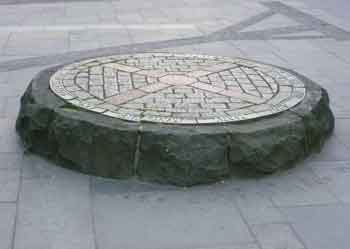
Archaeologists also exposed forgotten sections of the Flodden Wall in the Grassmarket and Cowgate, built as the citizens of Edinburgh awaited an English army under the Earl of Surrey, following the defeat and death of King James IV at the Battle of Flodden in 1513.
The Wall is perhaps best seen in the Vennel, once a rather gloomy and claustrophobic passage.
It ascended from the Grassmarket towards the imposing George Heriot’s Hospital, now a school, the legacy of the jeweller, goldsmith and financier to King James VI and his extravagant queen.
the Porteous Riots
Perhaps more than any other incident, the Porteous Riots in 1736 highlighted the volatility of the Grassmarket area revealing the darker side of Old Town life.
Much has been written about Captain Porteous, the captain of Edinburgh’s town guard, and his conduct during the execution of one Andrew Wilson on the Grassmarket gibbet.
Sir Walter Scott in The Heart of Midlothian captures the mood better than most. He said, “One part of his [Porteous] conduct was truly diabolical. “it has not been exaggerated by the general prejudice against his memory.”
Scott was referring to the unnecessary use of force used by Porteous, fearing a rescue attempt, to restrain Wilson.
The execution was carried out but the excess cruelty had incensed the watching crowd who turned on Porteous and his men. In an effort to flee, his soldiers fired shots at the crowd killing a number of them.
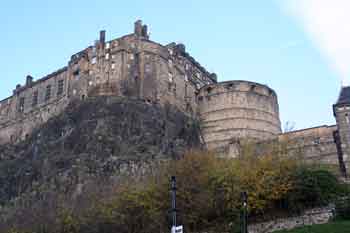
Grassmarket scaffold
The full story of the subsequent trial, at the High Court of Justiciary, of Edinburgh’s captain of the guard, is a detailed one.
Porteous was convicted of wilful murder and sentenced to hang on the same Grassmarket scaffold as the unfortunate Andrew Wilson.
At the allotted time of execution, the crowd waited, with some anticipation, for the sentence to be carried out.
Again Scott paints a wonderfully evocative picture of the scene, describing the area around the scaffold as a “sea of human heads at the centre of which arose the fatal tree, tall, black and ominous from which dangled the deadly halter.”
However, when there was no sign of the condemned man making his final appearance, the crowd, perhaps learning that Porteous had just received a royal pardon, decided to take matters into their own hands.
In their fury, the doors to the Tolbooth were burned down allowing them to drag out Porteous and lynch him on a dyer’s (barber’s) pole.
The story of Porteous and Wilson is well documented but there are many others who met a grisly end at the hands of the city hangmen who plied their unsavoury trade from the time of the Restoration in 1660 until 1784.
While the Edinburgh city annals document a long list of miscreants who ended their life on the Grassmarket gibbet, the area is inextricably linked with the fate of the Covenanters.
The signing of the National Covenant
The signing of the National Covenant at Edinburgh’s Greyfriars Kirk, overlooking the Grassmarket, in February 1638.
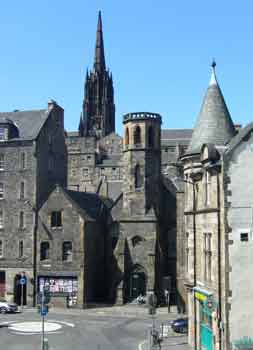
It started a movement against the introduction, by King Charles 1 and Archbishop of Canterbury William Laud, of a new English style prayer book into the Scottish kirk.
Those (Covenanters) who expressed their anger over the king’s single-minded attempt to impose a new liturgy into Scotland’s church perhaps never envisaged the cataclysmic events that their stubborn opposition would involve them in.
The following years saw the start of the English Civil War, the execution of Charles I, and the rise of Oliver Cromwell.
The Restoration of the monarchy (Charles II) saw the abolition of the National Covenant and all legislation enacted by Covenanting governments was revoked.
However many Covenanters refused to acquiesce and were persecuted during both Charles’s reign and his brother James VII (II) who took the throne in 1685.
Greyfriars Kirkyard
A plaque in Greyfriars Kirkyard is a poignant reminder that over a thousand Covenanters were imprisoned there following the Battle of Bothwell Brig in 1679.
They languished there before being transported to the American colonies or sent, “to glorify God in the Grassmarket.”
Today a Covenanter’s Memorial, set close to the site of the Grassmarket gallows, featuring a Martyr’s Cross, is a lasting testament to their cause. The inscription reads, “Many Martyrs and Covenanters died for the Protestant Faith on this spot.”
By the middle of the 18th century the Grassmarket was a lively spot – still a working class area with sheep and cattle fairs. Its cobbled streets street packed with horses and carts as people went about their business.
Grassmarket Edinburgh pub: White Hart Inn
It was the place where many of the town’s inns including the, still in existence, White Hart Inn, which Robert Burns visited in 1791, offered sustenance to locals and visiting drovers alike.
For those heading south of the border, it was the point where, “God Wullin,” travellers would board their coach.
Set above this maelstrom, perched high in one of the towering lands (tenement building) was the rare oasis of calm that was Mammy Smith’s school, where boys and girls would learn their ABCs and study their Bibles in the best Scottish tradition.
Perhaps in acknowledgement of Edinburgh’s status as UNESCO’s first City of Literature some words on the Grassmarket’s unique and occasionally sullen character might be left to David Balfour the youthful hero in Robert Louis Stevenson’s Kidnapped, first published in 1886.
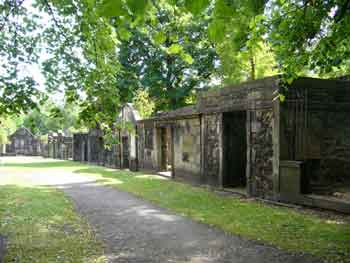
Stevenson noted, “the huge height of the buildings, running up to ten and fifteen stories, the narrow arched entries that continually vomited passengers, the wares of the merchants in their windows,
” the hubbub and endless stir, the foul smells and fine clothes, and a hundred other particulars too small to mention, struck me into a kind of stupor of surprise.”
The Cowgate
Like the Grassmarket, the Cowgate was originally the site for a number of different markets, the Society of Antiquaries of Scotland mentions, in a detailed investigation of the area: hay, straw, grass and horsemeat markets.
It was also, according to Alexander Alesse, a 16th century Edinburgh chronicler, “fashionable and aristocratic” an area, which he said, housed the “nobility and chief senators of the city.”
Cardinal Beaton, Archbishop of Glasgow and later St Andrews had a house on the north side of a site that originally consisted of outdoor workspaces and a few houses; records show that King James V lodged there in 1528.
Another associated with the site was Francisco de Busso, servant to Mary Queen of Scots, later jailed for his part in the murder of Lord Darnley, Mary’s second husband, in 1567.
Gentleman of the Bedchamber
During the late 16th and early 17th centuries Dr John Naysmith, surgeon to James VI maintained the royal connection with the area. Naysmith’s son-in-law John Livingston, also a resident of the Cowgate, had the wonderfully entitled position of Gentleman of the Bedchamber to Charles I.
Edinburgh City Improvements Act
The Cunyie House, as the Scottish Mint was once called, was built in 1574 on the north side of the Cowgate between South Gray’s Close and Todrick’s Wynd, a narrow thoroughfare which would later deteriorate into perhaps the most squalid part of the Old Town until swept away in the changes enforced by the Edinburgh City Improvement Act of 1867.
Other buildings, later added to the Mint to form an orderly courtyard, were used as a debtors’ court and, said writer and publisher Robert Chambers, a “jail for debtors and other delinquents condemned by the Mint’s own officers.”
There was also a large hall used for banquets and functions, in May 1590 for example it was used to entertain Danish Lords following the wedding of Anne of Denmark to King James VI.
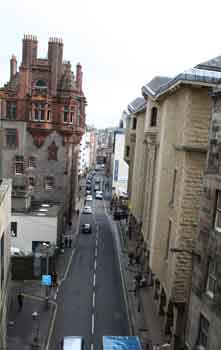
Today a walker on Edinburgh’s George IV Bridge might pause to look down on the bustling Cowgate and pass comment on the scene, just as Robert Louis Stevenson once did.
While Stevenson saw “teeming miseries and ranks of “crying hawkers” the image presented today, despite a number of busy pubs and entertainment venues, is that of a rather stark and functional passageway.
Magdalen Chapel
However for the inquisitive researcher, there are still occasional reminders of an earlier prestige, the best of which is Magdalen Chapel, the last Roman Catholic chapel to be built (1541-44) in Edinburgh before the Reformation.
Certainly, when Robert Chambers cast his inquisitive eye over the Old Town’s once desirable addresses they were less inviting, grittier places shaped not only by their physical environment but also by Scotland’s seemingly ever-changing political and religious evolution.
Chambers said, “the most superb streets, the handsomest squares and the most fashionable wynds of the former period are now degraded into the most plebian parts of the town…”
West Bow
For three centuries the West Bow formed part of the main entry into Edinburgh’s “upper town.” Described by one early writer as, “a curious, angular, whimsical looking street of great steepness and narrowness and of great connection between the Grassmarket and Lawnmarket.”
As such it would have witnessed the grand processions of royal carriages as their occupants went about the business of state as well as the parade of merchants who wished to do business on the Royal Mile.
Although long since replaced with a street of less threatening gradient the West Bow remains one of the main arteries between the Grassmarket and the Royal Mile. At its foot lies the Bow Well built in 1674, the first wellhead in the gravity system which drew from the Castle Hill reservoir to supply the first piped water to the Grassmarket.
West Port
The West Port is a short stroll from the still boisterous Grassmarket. Today it offers visitors and students from nearby Edinburgh University a row of dusty secondhand bookshops and a small collection of art house venues.
Turn the clock back to 1828 and the West Port with its grimy and threatening Edinburgh closes became a central player during the nefarious activities of Burke and Hare as they competed with the grave robbers by murdering and selling their victims to Doctor Robert Knox’s School of Anatomy.
Mary of Guise
It was the ancient western gate into the city, Mary of Guise, mother to Mary Queen of Scots and Regent of Scotland, one of the most remarkable women to stride Scotland’s historic stage, passed this way with, “greit triumphe” in 1538 as did the less impressive Marion Purdy, “once a milkwife, latterly a beggar, charged in 1684 with witchcraft for, “laying frenzies and diseases on her neighbours.”
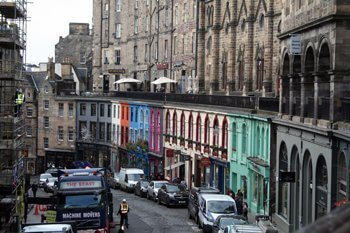
The West Port also displayed a more sinister message to those entering the capital in the shape of a series of spikes often decorated with the heads of those who had fallen foul of the law.
Usually reserved for the “ruffians” of Edinburgh society, Sir Robert Graham one of the killers of James I (1437) was spiked here, while the heads of the Marquis of Montrose and the Marquis of Argyll and others of a “similar class” stared down from a spike in the Tolbooth.
Edinburgh’s Old Town streets once deemed part of the city’s underbelly, are perhaps less aesthetically pleasing than others but nonetheless have a rich historical resonance and a special place in the development of Scotland’s capital city and as such are worthy of exploration.